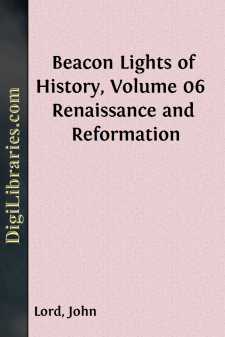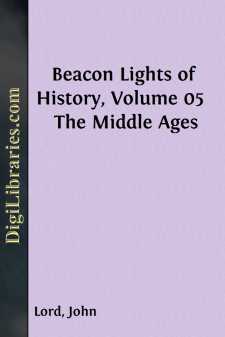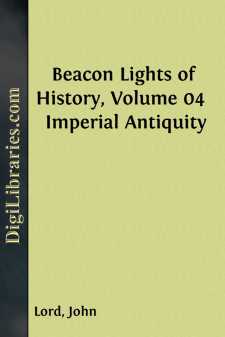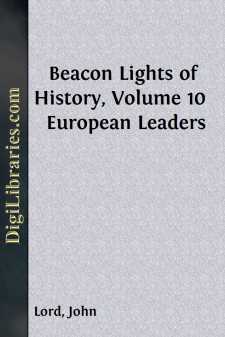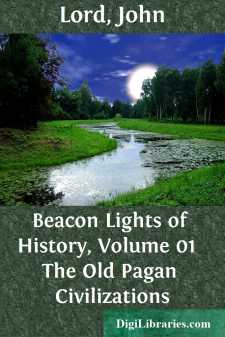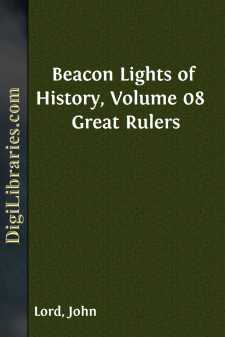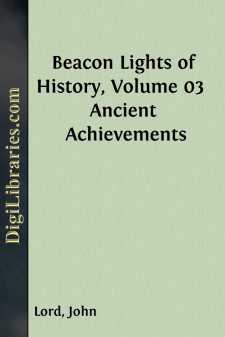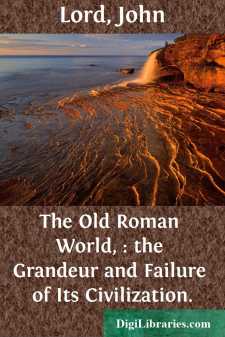Categories
- Antiques & Collectibles 13
- Architecture 36
- Art 48
- Bibles 22
- Biography & Autobiography 813
- Body, Mind & Spirit 142
- Business & Economics 28
- Children's Books 15
- Children's Fiction 12
- Computers 4
- Cooking 94
- Crafts & Hobbies 4
- Drama 346
- Education 46
- Family & Relationships 57
- Fiction 11828
- Games 19
- Gardening 17
- Health & Fitness 34
- History 1377
- House & Home 1
- Humor 147
- Juvenile Fiction 1873
- Juvenile Nonfiction 202
- Language Arts & Disciplines 88
- Law 16
- Literary Collections 686
- Literary Criticism 179
- Mathematics 13
- Medical 41
- Music 40
- Nature 179
- Non-Classifiable 1768
- Performing Arts 7
- Periodicals 1453
- Philosophy 64
- Photography 2
- Poetry 896
- Political Science 203
- Psychology 42
- Reference 154
- Religion 513
- Science 126
- Self-Help 84
- Social Science 81
- Sports & Recreation 34
- Study Aids 3
- Technology & Engineering 59
- Transportation 23
- Travel 463
- True Crime 29
Beacon Lights of History, Volume 06 Renaissance and Reformation
by: John Lord
Description:
Excerpt
MICHAEL ANGELO.
A.D. 1475-1564.
THE REVIVAL OF ART.
Michael Angelo Buonarroti--one of the Great Lights of the new civilization--may stand as the most fitting representative of reviving art in Europe; also as an illustrious example of those virtues which dignify intellectual pre-eminence. He was superior, in all that is sterling and grand in character, to any man of his age,--certainly in Italy; exhibiting a rugged, stern greatness which reminds us of Dante, and of other great benefactors; nurtured in the school of sorrow and disappointment, leading a checkered life, doomed to envy, ingratitude, and neglect; rarely understood, and never fully appreciated even by those who employed and honored him. He was an isolated man; grave, abstracted, lonely, yet not unhappy, since his world was that of glorious and exalting ideas, even those of grace, beauty, majesty, and harmony,--the world which Plato lived in, and in which all great men live who seek to rise above the transient, the false, and puerile in common life. He was also an original genius, remarkable in everything he attempted, whether as sculptor, painter, or architect, and even as poet. He saw the archetypes of everything beautiful and grand, which are invisible except to those who are almost divinely gifted; and he had the practical skill to embody them in permanent forms, so that all ages may study those forms, and rise through them to the realms in which his soul lived.
Michael Angelo not only created, but he reproduced. He reproduced the glories of Grecian and Roman art. He restored the old civilization in his pictures, his statues, and his grand edifices. He revived a taste for what is imperishable in antiquity. As such he is justly regarded as an immortal benefactor; for it is art which gives to nations culture, refinement, and the enjoyment of the beautiful. Art diverts the mind from low and commonplace pursuits, exalts the imagination, and makes its votary indifferent to the evils of life. It raises the soul into regions of peace and bliss.
But art is most ennobling when it is inspired by lofty and consecrated sentiments,--like those of religion, patriotism, and love. Now ancient art was consecrated to Paganism. Of course there were noble exceptions; but as a general rule temples were erected in honor of heathen deities. Statues represented mere physical strength and beauty and grace. Pictures portrayed the charms of an unsanctified humanity. Hence ancient art did very little to arrest human degeneracy; facilitated rather than retarded the ruin of states and empires, since it did not stimulate the virtues on which the strength of man is based: it did not check those depraved tastes and habits which are based on egotism.
Now the restorers of ancient art cannot be said to have contributed to the moral elevation of the new races, unless they avoided the sensualism of Greece and Rome, and appealed purely to those eternal ideas which the human mind, even under Pagan influences, sometimes conceived, and which do not conflict with Christianity itself.
In considering the life and labors of Michael Angelo, then, we are to examine whether, in the classical glories of antiquity which he substituted for the Gothic and Mediaeval, he advanced civilization in the noblest sense; and moreover, whether he carried art to a higher degree than was ever attained by the Greeks and Romans, and hence became a benefactor of the world.
In considering these points I shall not attempt a minute criticism of his works. I can only seize on the great outlines, the salient points of those productions which have given him immortality. No lecture can be exhaustive. If it only prove suggestive, it has reached its end.
Michael Angelo stands out in history in the three aspects of sculptor, painter, and architect; and that too in a country devoted to art, and in an age when Italy won all her modern glories, arising from the matchless works which that age produced. Indeed, those works will probably never be surpassed, since all the energies of a great nation were concentrated upon their production, even as our own age confines itself chiefly to mechanical inventions and scientific research and speculation. What railroads and telegraphs and spindles and chemical tests and compounds are to us; what philosophy was to the Greeks; what government and jurisprudence were to the Romans; what cathedrals and metaphysical subtilties were to the Middle Ages; what theological inquiries were to the divines of the seventeenth century; what social urbanities and refinements were to the French in the eighteenth century,--the fine arts were to the Italians in the sixteenth century: a fact too commonplace to dwell upon, and which will be conceded when we bear in mind that no age has been distinguished for everything, and that nations can try satisfactorily but one experiment at a time, and are not likely to repeat it with the same enthusiasm. As the mind is unbounded in its capacities, and our world affords inexhaustible fields of enterprise, the progress of the race is to be seen in the new developments which successively appear, but in which only a certain limit has thus far been reached. Not in absolute perfection in any particular sphere is this progress seen, but rather in the variety of the experiments. It may be doubted whether any Grecian edifice will ever surpass the Parthenon in beauty of proportion or fitness of ornament; or any nude statue show grace of form more impressive than the Venus de Milo or the Apollo Belvedere; or any system of jurisprudence be more completely codified than that systematized by Justinian; or any Gothic church rival the lofty expression of Cologne cathedral; or any painting surpass the holy serenity and ethereal love depicted in Raphael's madonnas; or any court witness such a brilliant assemblage of wits and beauties as met at Versailles to render homage to Louis XIV.; or any theological discussion excite such a national interest as when Luther confronted Doctor Eck in the great hall of the Electoral Palace at Leipsic; or any theatrical excitement such as was produced on cultivated intellects when Garrick and Siddons represented the sublime conceptions of the myriad-minded Shakspeare. These glories may reappear, but never will they shine as they did before. No more Olympian games, no more Roman triumphs, no more Dodona oracles, no more Flavian amphitheatres, no more Mediaeval cathedrals, no more councils of Nice or Trent, no more spectacles of kings holding the stirrups of popes, no more Fields of the Cloth of Gold, no more reigns of court mistresses in such palaces as Versailles and Fontainbleau,--ah! I wish I could add, no more such battlefields as Marengo and Waterloo,--only copies and imitations of these, and without the older charm. The world is moving on and perpetually changing, nor can we tell what new vanity will next arise,--vanity or glory, according to our varying notions of the dignity and destiny of man. We may predict that it will not be any mechanical improvement, for ere long the limit will be reached,--and it will be reached when the great mass cannot find work to do, for the everlasting destiny of man is toil and labor. But it will be some sublime wonders of which we cannot now conceive, and which in time will pass away for other wonders and novelties, until the great circle is completed; and all human experiments shall verify the moral wisdom of the eternal revelation. Then all that man has done, all that man can do, in his own boastful thought, will be seen, in the light of the celestial verities, to be indeed a vanity and a failure, not of human ingenuity and power, but to realize the happiness which is only promised as the result of supernatural, not mortal, strength, yet which the soul in its restless aspirations never ceases its efforts to secure,--everlasting Babel-building to reach the unattainable on earth.
Now the revival of art in Italy was one of the great movements in the series of human development. It peculiarly characterized the fifteenth and sixteenth centuries. It was an age of artistic wonders, of great creations.
Italy, especially, was glorious when Michael Angelo was born, 1474; when the rest of Europe was comparatively rude, and when no great works in art, in poetry, in history, or philosophy had yet appeared. He was descended from an illustrious family, and was destined to one of the learned professions; but he could not give up his mind to anything but drawing,--as annoying to his father as Galileo's experiments were to his parent; as unmeaning to him as Gibbon's History was to George III.,--"Scribble, scribble, scribble; Mr. Gibbon, I perceive, sir, you are always a-scribbling." No perception of a new power, no sympathy with the abandonment to a specialty not indorsed by fashions and traditions, but without which abandonment genius cannot easily be developed. At last the father yielded, and the son was apprenticed to a painter,--a degradation in the eyes of Mediaeval aristocracy.
The celebrated Lorenzo de' Medici was then in the height of power and fame in Florence, adored by Roscoe as the patron of artists and poets, although he subverted the liberties of his country. This over-lauded prince, heir of the fortunes of a great family of merchants, wishing to establish a school for sculpture, filled a garden with statues, and freely admitted to it young scholars in art. Michael Angelo was one of the most frequent and enthusiastic visitors to this garden, where in due time he attracted the attention of the magnificent Lord of Florence by a head chiselled so remarkably that he became an inmate of the palace, sat at the table of Lorenzo, and at last was regularly adopted as one of the Prince's family, with every facility for prosecuting his studies. Before he was eighteen the youth had sculptured the battle of Hercules with the Centaurs, which he would never part with, and which still remains in his family; so well done that he himself, at the age of eighty, regretted that he had not given up his whole life to sculpture.
It was then as a sculptor that Michael Angelo first appears to the historical student,--about the year 1492, when Columbus was crossing the great unknown ocean to realize his belief in a western passage to India. Thus commercial enterprise began with the revival of art, and was destined never to be separated in its alliance with it, since commerce brings wealth, and wealth seeks to ornament the palaces and gardens which it has created or purchased. The sculptor's art was not born until piety had already edifices in which to worship God, or pride the monuments in which it sought the glories of a name; but it made rapid progress as wealth increased and taste became refined; as the need was felt for ornaments and symbols to adorn naked walls and empty spaces, especially statuary, grouped or single, of men or animals,--a marble history to interpret or reproduce consecrated associations. Churches might do without them; the glass stained in every color of the rainbow, the altar shining with gold and silver and precious stones, the pillars multiplied and diversified, and rich in foliated circles, mullions, mouldings, groins, and bosses, and bearing aloft the arched and ponderous roof,--one scene of dazzling magnificence,--these could do without them; but the palaces and halls and houses of the rich required the image of man,--and of man not emaciated and worn and monstrous, but of man as he appeared to the classical Greeks, in the perfection of form and physical beauty. So the artists who arose with the revival of commerce, with the multiplication of human wants and the study of antiquity, sought to restore the buried statues with the long-neglected literature and laws. It was in sculptured marbles that enthusiasm was most marked. These were found in abundance in various parts of Italy whenever the vast débris of the ancient magnificence was removed, and were universally admired and prized by popes, cardinals, and princes, and formed the nucleus of great museums.
The works of Michael Angelo as a sculptor were not numerous, but in sublimity they have never been surpassed,--non multa, sed multum. His unfinished monument of Julius II., begun at that pontiff's request as a mausoleum, is perhaps his greatest work; and the statue of Moses, which formed a part of it, has been admired for three hundred years. In this, as in his other masterpieces, grandeur and majesty are his characteristics. It may have been a reproduction, and yet it is not a copy. He made character and moral force the first consideration, and form subservient to expression. And here he differed, it is said by great critics, from the ancients, who thought more of form than of moral expression,--as may be seen in the faces of the Venus de Medici and the Apollo Belvedere, matchless and inimitable as these statues are in grace and beauty. The Laocoön and the Dying Gladiator are indeed exceptions, for it is character which constitutes their chief merit,--the expression of pain, despair, and agony. But there is almost no intellectual or moral expression in the faces of other famous and remarkable antique statues, only beauty and variety of form, such as Powers exhibited in his Greek Slave,--an inferior excellence, since it is much easier to copy the beautiful in the nude statues which people Italy, than to express such intellectual majesty as Michael Angelo conceived--that intellectual expression which Story has succeeded in giving to his African Sibyl. Thus while the great artist retained the antique, he superadded a loftiness such as the ancients rarely produced; and sculpture became in his hands, not demoralizing and Pagan, resplendent in sensual charms, but instructive and exalting,--instructive for the marvellous display of anatomical knowledge, and exalting from grand conceptions of dignity and power. His knowledge of anatomy was so remarkable that he could work without models. Our artists, in these days, must always have before their eyes some nude figure to copy.
The same peculiarities which have given him fame as a sculptor he carried out into painting, in which he is even more remarkable; for the artists of Italy at this period often combined a skill for all the fine arts. In sculpture they were much indebted to the ancients, but painting seems to have been purely a development. In the Middle Ages it was comparatively rude. No noted painter arose until Cimabue, in the middle of the thirteenth century. Before him, painting was a lifeless imitation of models afforded by Greek workers in mosaics; but Cimabue abandoned this servile copying, and gave a new expression to heads, and grouped his figures. Under Giotto, who was contemporary with Dante, drawing became still more correct, and coloring softer. After him, painting was rapidly advanced. Pietro della Francesca was the father of perspective; Domenico painted in oil, discovered by Van Eyck in Flanders, in 1410; Masaccio studied anatomy; gilding disappeared as a background around pictures. In the fifteenth century the enthusiasm for painting became intense; even monks became painters, and every convent and church and palace was deemed incomplete without pictures. But ideal beauty and harmony in coloring were still wanting, as well as freedom of the pencil. Then arose Da Vinci and Michael Angelo, who practised the immutable principles by which art could be advanced; and rapidly following in their steps, Fra Bartolommeo, Fra Angelico, Rossi, and Andrea del Sarto made the age an era in painting, until the art culminated in Raphael and Corregio and Titian. And divers cities of Italy--Bologna, Milan, Parma, and Venice--disputed with Rome and Florence for the empire of art; as also did many other cities which might be mentioned, each of which has a history, each of which is hallowed by poetic associations; so that all men who have lived in Italy, or even visited it, feel a peculiar interest in these cities,--an interest which they can feel in no others, even if they be such capitals as London and Paris. I excuse this extravagant admiration for the wonderful masterpieces produced in that age, making marble and canvas eloquent with the most inspiring sentiments, because, wrapt in the joys which they excite, the cultivated and imaginative man forgets--and rejoices that he can forget--the priests and beggars, the dirty hotels, filthy friars, superstition, unthrift, Jesuitism, which stare ordinary tourists in the face, and all the other disgusting realities which philanthropists deplore so loudly in that degenerate but classical and ever-to-be-hallowed land. For, come what will, in spite of popes and despots it has been the scene of the highest glories of antiquity, calling to our minds saints and martyrs, as well as conquerors and emperors, and revealing at every turn their tombs and broken monuments, and all the hoary remnants of unsurpassed magnificence, as well as preserving in churches and palaces those wonders which were created when Italy once again lived in the noble aspiration of making herself the centre and the pride of the new civilization.
Da Vinci, the oldest of the great masters who immortalized that era, died in 1519, in the arms of Francis I. of France, and Michael Angelo received his mantle. The young sculptor was taken away from his chisel to paint, for Pope Julius II., the ceiling of the Sistine Chapel. After the death of his patron Lorenzo, he had studied and done famous work in marble at Bologna, at Rome, and again at Florence. He had also painted some, and with such immediate success that he had been invited to assist Da Vinci in decorating a hall in the ducal palace at Florence. But sculpture was his chosen art, and when called to paint the Sistine Chapel, he implored the Pope that he might be allowed to finish the mausoleum which he had begun, and that Raphael, then dazzling the whole city by his unprecedented talents, might be substituted for him in that great work. But the Pope was inflexible; and the great artist began his task, assisted by other painters; however, he soon got disgusted with them and sent them away, and worked alone. For twenty months he toiled, rarely seen, living abstemiously, absorbed utterly in his work of creation; and the greater portion of the compartments in the vast ceiling was finished before any other voice than his, except the admiring voice of the Pope, pronounced it good.
It would be useless to attempt to describe those celebrated frescos. Their subjects were taken from the Book of Genesis, with great figures of sibyls and prophets. They are now half-concealed by the accumulated dust and smoke of three hundred years, and can be surveyed only by reclining at full length on the back. We see enough, however, to be impressed with the boldness, the majesty, and the originality of the figures,--their fidelity to nature, the knowledge of anatomy displayed, and the disdain of inferior arts; especially the noble disdain of appealing to false and perverted taste, as if he painted from an exalted ideal in his own mind, which ideal is ever associated with creative power.
It is this creative power which places Michael Angelo at the head of the artists of his great age; and not merely the power to create but the power of realizing the most exalted conceptions. Raphael was doubtless superior to him in grace and beauty, even as Titian afterwards surpassed him in coloring. He delighted, like Dante, in the awful and the terrible. This grandeur of conception was especially seen in his Last Judgment, executed thirty years afterwards, in completion of the Sistine Chapel, the work on which had been suspended at the death of Julius. This vast fresco is nearly seventy feet in height, pain


